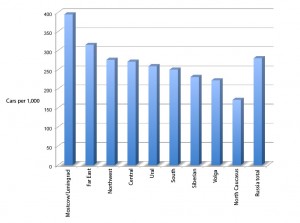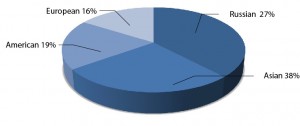Opportunites for Russian CKDs
Russian government policy has pushed carmakers in Russia and Central Asia toward expansion by kit assembly methods. Logistics is playing a critical role and providers are likely to see more opportunities.
Big plans for Russia: many OEMs will double production in Russia by 2016, largely through kit assembly
In recent years Russia has seen a rush of investment in production capacity by foreign carmakers. OEMs including Renault Nissan, General Motors, Volkswagen and Ford have all planned to more than double production levels in Russia between 2011 and 2016. New players have also begun assembling vehicles in Russia or its Custom Union partners (Belarus and Kazakhstan), including Chinese brands like Geely and Lifan.
In 2012, vehicle production in Russia increased 12% from 2011 to more than 2.2m vehicles. That’s four times higher than at the pit of the crisis in 2009, and 50% higher than in 2008, according to PWC, when Russia’s new vehicle sales were at a comparable level to today (around 2.8m light vehicles per year). PWC forecasts that production will increase to 2.9m units by 2016. According to separate studies by the Boston Consulting Group and the Russian Ministry of Industry and Trade, the country could become the fifth largest producer and seller of cars in the world by 2020 after China, the US, India and Brazil.
On the surface, this capacity growth might seem the natural result of Russia being one of the world’s most important emerging markets. However, Russian industrial policy has driven much of the increase. A number of carmakers signed ‘decree 166’ in 2011, which mandated production capacity of 300,000 units a year within four years, or 350,000 units if upgrading existing plants. Localisation rates must also eventually hit 60%, according to Alexander Vassiliev a member of the Russian Parliament Committee on Transport Issues. In exchange, most import duties would be 0-5% up to 2020. Some tier suppliers also signed a similar decree, 566.
Despite joining the World Trade Organisation last year, Russia has also retained high import duties on finished vehicles and recycling charges on imports by manufacturers without local assembly. Government subsidies and support have also been promised to the 166 carmakers during 2018-2020, when Russia must decrease import duties on all components as a result of its WTO membership last year. Although Russia’s initial growth phase during the last decade was fuelled by imports, policy has clearly pushed the current expansion toward local assembly.
Vehicles assembled: 2.2m (+12% change on 2011)of which SKD/CKD: 1.314m (+23.5%)
The rise of CKD
This capacity expansion has been a challenge for the supply chain in Russia. While it is a relatively large market for new vehicles, it is not necessarily a technical and design centre for foreign manufacturers, who tend to engineer the vehicles elsewhere and then adapt them for the Russian market. While the country has a large local supplier base serving Russian carmakers such as Avtovaz, Gaz and Sollers, many suppliers trail the quality and technical requirements of global carmakers. These factors mean that most vehicle assembly in Russia depends on established supply bases, whether in Europe, Asia or North America.
The Russian vehicle market also remains erratic, and tier suppliers have shown reluctance to invest in capacity. The memory of 2009, when the market halved, is still fresh. This has not been helped by a sales decline this year. While Russia is still widely expected to overtake Germany as the largest market in Europe sometime over the next decade, the Association for European Business in Russia forecasts 2013 sales to fall by around 5%.
Local-assembly policies, a weak supply base, and an uncertain market have contributed to a high level of semi-knockdown and complete-knockdown kit (SKD and CKD) production in Russia. According to Vassiliev, the growth has been particularly strong for CKD, as the 166 agreements stipulated that SKD should not exceed 5% of assembly.
"These [CKD] supply chains were formed by a complex organisation based on the relationships between the world's largest automakers, their Russian divisions, local dealers, banks and insurance companies," Stanley Ruth, PWC Russia
Last year, more than 1.3m vehicles were assembled by kit methods, up 23.5% from 2011 and more than two-third of total production, including an even larger percentage among foreign OEMs.
According to Stanley Ruth, practice leader for the automotive industry at PWC Russia, the growth of CKD supply chains “from scratch” over the past decade has given the Russian consumer access to global brands at competitive prices. “These supply chains were formed by a complex organisation based on the relationships between the world's largest automakers, their Russian divisions, local dealers, banks and insurance companies,” he says.
For CKD, logistic is a distinct competitive advantage, as supply chains stretch from Russia back to Japan, South Korea, China, US, Mexico and Germany. There are even some links between the market share of OEMs and the proximity to their vehicles’ home supply bases, demonstrated to some extent by a higher share for Asian brands in the Far East and for European brands in the west.
 Volkswagen has expanded its CKD capacity at its plant in Kaluga
Volkswagen has expanded its CKD capacity at its plant in KalugaThe logistics for CKD are also complex and costly within Russia, with state subsidies skewing distribution patterns to some extent. Assembly points are scattered across the country, with many plant locations driven by regional tax and customs incentives. For those operating in the Far East, there is even a government subsidy to transport finished vehicles to Russia’s primary markets in central and western regions.
The complexity and growth represent opportunities for logistics providers. Although OEMs are striving for further localisation, in at least the medium-term that look sets to mean transition from SKD to CKD, as has been seen for Volkswagen Group production and Peugeot-Citroën at their respective plants in Kaluga. Russian government officials expect that despite the market’s current declines, CKD assembly should continue to see double-digit increases each year as carmakers pursue their 2016 targets, and that Russia will eventually add another 1.5m units of production by 2020, most of it on existing CKD lines. Government-influenced supply networks
A large amount of that expansion is set to come from production partnerships between foreign OEMs and Russian carmakers. One of the oldest and largest examples of such partnerships has been Avtotor in Kaliningrad, which assembled 249,600 vehicles last year mainly from SKD kits for BMW, Kia, Chevrolet and Opel. More recently, Gaz Group has begun assembling SKD and CKD vehicles for GM, Volkswagen and Daimler in Nizhny Novgorod; Ford is also assembling kits together with joint-venture partner Sollers in St Petersburg and Tatarstan.
 Last year Magna and Avtotor signed an agreement in Kaliningrad, which set the groundwork for upgrading from SKD assembly to CKD
Last year Magna and Avtotor signed an agreement in Kaliningrad, which set the groundwork for upgrading from SKD assembly to CKDAsian brands outside the 166 agreements have also partnered with Russian manufacturers: Chinese brands Geely and Lifan are assembling kits with Derways in Cherkessk, southern Russia. Toyota, Mazda and Ssangyong, meanwhile, are increasing kit assembly at a Sollers plant in the Russian Far East.
The regional spread of this production leads to challenges in moving material across Russia’s vast landscape. The supply chain complexity is partly the result of policy again, with Russia having granted reduced customs duties to special economic zones, including those in Kaliningrad and Tatarstan, which in particular encouraged Ford to setup its joint venture with Sollers.
A good example of how that policy continues to impact the supply chain can be found in a cooperation agreement signed last last year between Avtotor in Kaliningrad and tier supplier Magna, including its contract manufacturing division, Magna Steyr. According to the companies, the agreement sets the groundwork for establishing ‘full-cycle vehicle production’, or upgrading to CKD assembly from SKD. The agreement would include the development of a number of assembly and joint-venture component plants, with both companies initially saying that production could reach 250,000 units in 2016 and 350,000 by 2018.Avtotor currently benefits from zero duty on imported parts because it is in the Kaliningrad special economic zone. However, that agreement is set to expire in a few years, and the new partnership will allow the Russian company and Magna to use the so-called ‘sleeping’ agreement on industrial assembly, according to a representative from Avtotor, who asks to remain anonymous. This means that rather than each company having to produce 200,000 units each per year to import parts duty free after 2016, one company can use the other’s benefits, which should reduce the amount of vehicles that both are required to assemble.According to the representative, the new venture will be named Avtotor-Magna Holding following Avtotor paying €1m ($1.33m) for a 60% stake in the venture. The company will assemble kits in both Nizhny Novgorod and Kaliningrad, he says.A helping hand for the Far East
 Sollers is assembling Ssangyong vehicles in Vladivostock: rail subsidies from the Far East have had an impact on the growth of production and transport spends in the region
Sollers is assembling Ssangyong vehicles in Vladivostock: rail subsidies from the Far East have had an impact on the growth of production and transport spends in the regionRussian industrial policy has also shaped the development of kit assembly and logistics distribution in the Far East. While most of Russia’s vehicle manufacturing is based in its western and central regions, where the majority of sales occur, some Asian OEMs have made use of better supply chain access to the Far East for moving kits shorter distances. South Korea-based Ssangyong, China’s Chery along with Toyota and Mazda are well represented in the Far East and Siberia, for example.
Clearly, the distance to Russian’s main consumption centres would supersede or equal any savings made for inbound logistics for these OEMs. But the government has helped eastern SKD/CKD producers by covering their logistic spends. According to a source at the Ministry of Industry and Trade, 4.9 billion roubles ($160m) have been allocated in this year’s budget in subsidies for the delivery of cars produced in Russia’s Far East to other federal regions. In the next two years, the state is going to spend another 6.5 billion roubles, the source says.A large part of this money will go to Sollers for its factory in Vladivostok. A spokesperson for Sollers admits that the subsidies are essential to the plant’s growth.
"The subsidies are directly connected with the growth of production and, consequently, transportation spends,” he says. “Our company has significantly increased the production of the Korean SUV Ssangyong. In addition, in the spring of 2013 we started mass production of the Mazda 6."
 Brand market share Moscow/Leningrad Oblast (source: Autostat)
Brand market share Moscow/Leningrad Oblast (source: Autostat) Car Penetration by Federal region (source: Alfastrahovanie, Regional Statistic Service)
Car Penetration by Federal region (source: Alfastrahovanie, Regional Statistic Service)Vladimir Bespalov, an analyst at the financial agency, VTB Capital, says that the subsidies are necessary to sustain assembly in Russia’s Far East. "At small amounts such production is impractical and the local market cannot itself absorb large amount of the cars that are produced here now,” he says.
This government support may also have indirectly helped Asian brands to grow their market share in Russia’s eastern regions, since it makes production for the local market more viable. According to Autostat, a Russian consultancy, Asian brands have the highest market share in the Vladivostock region at 38%, and Europeans the lowest at 16%.
 Brand market share Vladivostok Oblast (source: Autostat)
Brand market share Vladivostok Oblast (source: Autostat)In the Moscow and Leningrad region, by contrast, Europeans hold the highest share at 27%.There are no subsidies available to transport cars from west to east in Russia. With Russian vehicle sales expected to rise faster in Russia’s central and eastern regions in the coming years, European and American producers could face some disadvantages, according to Denis Shishkin, manager of car distributor Major.
"The European brands with their main production assets near Kaliningrad and Kaluga spend more on logistic in these areas, which often affects price and logistics, including for spare parts,” he says.
Although the Russian market is expected to recover from its current declines, a number of forecasts indicate that it may reach its peak by 2020. That has lead some OEMs to look at growth opportunities in neighbouring countries, where car ownership levels are much lower. SKD and CKD manufacturing has already started to grow in markets such as Kazakhstan, Uzbekistan, the Ukraine, Belarus and Kyrgyzstan.
 Experts say that manufacturers will further localise SKD and CKD ventures in Russia
Experts say that manufacturers will further localise SKD and CKD ventures in RussiaSuch markets also represent export destinations. Vehicles assembled usually have limited export potential; given the inbound logistics and customs costs for importing the material, exporting the finished vehicles is rarely competitive. However, Russia’s Customs Union, which includes Belarus and Kazakhstan and may eventually include Uzbekistan, means that manufacturers can extend their existing supply chains and sales channels without additional distribution, marketing and customs costs. GM has a large joint venture plant in Uzbekistan that assembles Chevrolets for the Uzbek and Russian market with kits from South Korea, for example. China’s Geely has also recently announced plans to expand kit production in Belarus for the domestic market and export to Russia.
Likewise, sales growth in Central Asia could lead to more export from Russian plants. A spokesperson from the Federal Customs Service predicts that in 2013 exports of cars abroad could reach 120,000 units, about one-third higher than in 2012. "According to preliminary forecasts the trend is gaining momentum, and by 2020 the country will be able to increase exports of cars by 2-3 times to meet the growing demand in the region of Central Asia," he says
However, the spokesperson admits that volatility in these markets, along with high logistics costs, could hold back demand. Industrial policy in such markets is unpredictable – Ukraine has recently introduced a recycling fee similar to Russia's and earlier this year it increased duties on vehicles to punitive levels, although the government has suggested that it would lower them. In either case, officials from OEMs such as Volkswagen have been cautious in expressing their expectations for export from Russia.
Igor Burenkov, an official from Russia’s Avtovaz, suggests that Russia will not become a net exporter anytime soon because the domestic market is far from saturation levels. “The Russian car market is growing, but its future will largely depend on the economic situation and the purchasing power of the population," he says.
The localisation effect
Experts say that manufacturers will further localise SKD and CKD ventures in Russia. Dmitry Levchenko, the director of the department of special economic zones and project finance at the Ministry of Economic Development, predicts that the country will attract 400 component manufacturers in the coming years as OEMs move towards the 60% target for localisation. For example, he points to a group of tier suppliers in Nizhny Novgorod that will create a joint venture with the Spanish tier one Zanini to produce wheel trims and emblems for cars. Levchenko says there are dozens of such agreements across the country.
"Localisation will definitely affect [CKD production], especially in the long-term prospects. Some producers probably will really abandon CKD in the coming years" - Dmitry Levchenko, Ministry of Economic Development
“Such localisation is very important. It leads directly to the depth of localisation, the arrival of new players, new investment, new jobs, the creation of added value, the development of related industries,” he says.
Those that achieve higher levels of localisation will move away from CKD assembly in the long term, although it is likely that tier suppliers will continue to import many CKD parts. Some OEMs, such as Ford, already plan to switch from kits to ‘full production’ as early as this year for some models – although in the medium term, at least, that probably means a move from SKD to CKD until parts can be localised further.“I do not think that this will lead to the end of CKD assembly in Russia, but localisation will definitely affect it, especially in the long-term prospects. Some producers probably will really abandon CKD in the coming years,” says Levchenko.
Christohper Ludwig contributed to this report.






